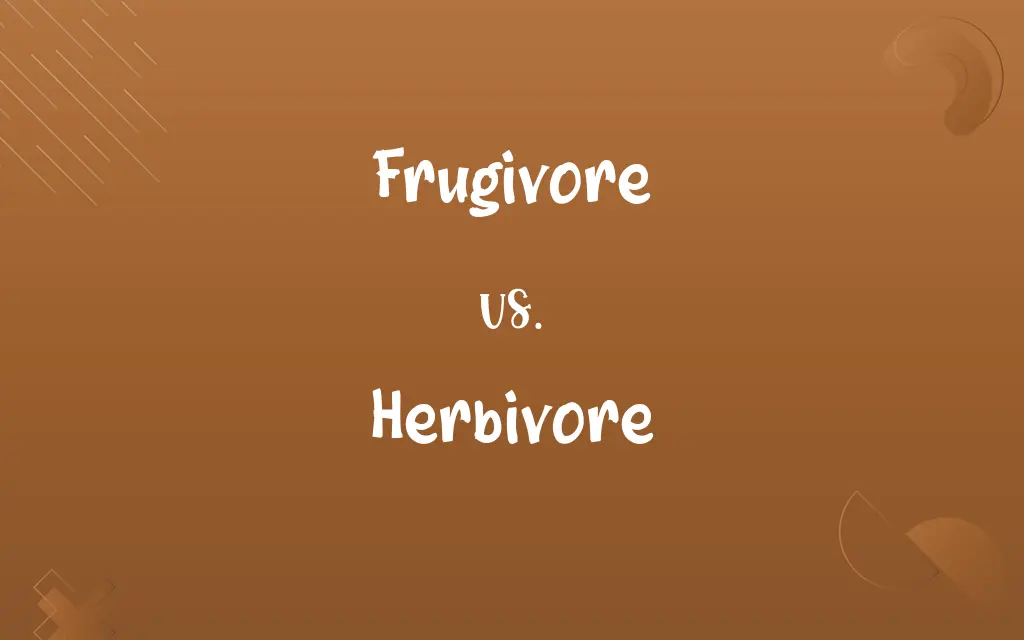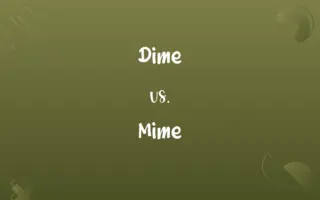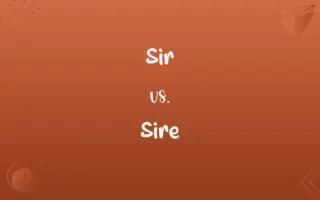Frugivore vs. Herbivore: Know the Difference

By Shumaila Saeed || Updated on February 23, 2024
A frugivore is an organism that primarily eats fruit, while a herbivore consumes plants, including leaves, stems, and roots. Frugivores play a key role in seed dispersal, whereas herbivores influence plant community structure and composition.

Key Differences
Frugivores are specialized in consuming fruits as their main source of nutrition. This diet allows them to play a crucial role in ecosystems by dispersing seeds through their feces, thus facilitating plant reproduction and the spread of various fruit-bearing plants. Herbivores, on the other hand, have a broader diet that includes various parts of plants such as leaves, stems, flowers, and roots. This group encompasses a wide range of animals, from large mammals like elephants and deer to insects like caterpillars.
Shumaila Saeed
Feb 23, 2024
Frugivores include certain species of birds, bats, primates, and even some fish, which have digestive systems and behaviors adapted to fruit consumption. Their preference for fruit means they often travel long distances to find ripe fruits, contributing to the geographic distribution of plants. Herbivores have significant ecological impacts, including controlling plant population and distribution, shaping plant communities, and serving as prey for carnivores and omnivores. Their eating habits can lead to a mutualistic relationship where plants provide nourishment and herbivores assist in pollination or seed dispersal, though not as directly as frugivores.
Shumaila Saeed
Feb 23, 2024
The main difference between frugivores and herbivores lies in their diet specificity and ecological roles. While frugivores are focused on fruit consumption and seed dispersal, herbivores engage in a broader consumption of plant materials, impacting plant growth and survival in various ways. Both groups are integral to their ecosystems, contributing to the balance of plant and animal populations and the functioning of food webs.
Shumaila Saeed
Feb 23, 2024
Comparison Chart
Diet
Primarily fruits.
Various plant parts including leaves, stems, and roots.
Shumaila Saeed
Feb 23, 2024
Ecological Role
Seed dispersal and plant reproduction.
Plant population control, community structuring, and pollination.
Shumaila Saeed
Feb 23, 2024
ADVERTISEMENT
Examples
Certain birds, bats, primates, and fish.
Elephants, deer, caterpillars, and cows.
Shumaila Saeed
Feb 23, 2024
Digestive Adaptations
Adapted to digest fruits efficiently.
Adapted to process cellulose from plant walls.
Shumaila Saeed
Feb 23, 2024
Impact on Vegetation
Facilitate the spread of fruit-bearing plants.
Influence plant growth patterns and community composition.
Shumaila Saeed
Feb 23, 2024
Frugivore and Herbivore Definitions
Frugivore
Specializes in eating fruit.
The toucan, a frugivore, plays a vital role in rainforest seed dispersal.
Shumaila Saeed
Feb 23, 2024
Herbivore
Consumes a variety of plant parts.
Cows, as herbivores, graze on grass throughout the day.
Shumaila Saeed
Feb 23, 2024
ADVERTISEMENT
Frugivore
Fruit-focused diet.
Orangutans, frugivores by nature, contribute to the biodiversity of their habitats.
Shumaila Saeed
Feb 23, 2024
Herbivore
Influences plant communities.
Large herbivores like elephants can shape the landscape by their feeding habits.
Shumaila Saeed
Feb 23, 2024
Frugivore
Adapted to fruit consumption.
Frugivores possess digestive systems that efficiently extract nutrients from fruits.
Shumaila Saeed
Feb 23, 2024
Herbivore
Integral to food webs.
Herbivores serve as a key food source for many carnivorous predators.
Shumaila Saeed
Feb 23, 2024
Frugivore
Ecosystem contributors.
Frugivorous fish in the Amazon help disperse fruit seeds along rivers.
Shumaila Saeed
Feb 23, 2024
ADVERTISEMENT
Herbivore
Varied plant diet.
Caterpillars feed on leaves, playing a role in controlling plant growth.
Shumaila Saeed
Feb 23, 2024
Frugivore
Key for seed dispersal.
Frugivores like bats are crucial for the propagation of many tropical plants.
Shumaila Saeed
Feb 23, 2024
Herbivore
Adapted to plant digestion.
Herbivores have evolved complex stomachs to break down cellulose.
Shumaila Saeed
Feb 23, 2024
Frugivore
An animal, such as a chimpanzee or fruit bat, that feeds primarily on fruit.
Shumaila Saeed
Oct 19, 2023
Herbivore
An organism that feeds chiefly on plants; an animal that feeds on herbage or vegetation as the main part of its diet.
Shumaila Saeed
Oct 19, 2023
Herbivore
Any animal that feeds chiefly on grass and other plants;
Horses are herbivores
The sauropod dinosaurs were apparently herbivores
Shumaila Saeed
Oct 19, 2023
Repeatedly Asked Queries
How do frugivores contribute to forest regeneration?
Frugivores contribute to forest regeneration by dispersing seeds away from the parent plant, increasing genetic diversity and plant spread.
Shumaila Saeed
Feb 23, 2024
Why is fruit consumption important for frugivores?
Fruit consumption provides essential nutrients and calories that are crucial for the energy demands of frugivores, supporting their growth, reproduction, and overall health.
Shumaila Saeed
Feb 23, 2024
How do changing seasons affect the feeding habits of frugivores and herbivores?
Changing seasons can significantly affect food availability, leading frugivores and herbivores to adapt their feeding habits, migrate, or enter periods of dormancy based on seasonal food supply.
Shumaila Saeed
Feb 23, 2024
Can an animal be both a frugivore and herbivore?
Yes, some animals have varied diets that include both fruits and other plant parts, making them both frugivores and herbivores depending on the food available.
Shumaila Saeed
Feb 23, 2024
What is the impact of invasive plant species on herbivores?
Invasive plant species can alter the diet and habitat of herbivores, potentially displacing native plant species that herbivores depend on for food.
Shumaila Saeed
Feb 23, 2024
How do frugivores and herbivores adapt to environmental stressors like drought or wildfires?
They may adapt through changes in diet, migration to areas with more abundant food sources, or physiological adaptations that allow them to utilize less preferred food sources during times of scarcity.
Shumaila Saeed
Feb 23, 2024
What adaptations do herbivores have for their diet?
Herbivores may have specialized teeth for grinding plant material, multi-chambered stomachs for digesting cellulose, and symbiotic gut bacteria to aid in breaking down tough plant fibers.
Shumaila Saeed
Feb 23, 2024
What conservation efforts are in place to protect frugivores and herbivores?
Conservation efforts include habitat restoration, creating wildlife corridors, legal protection against hunting and poaching, and initiatives to combat climate change.
Shumaila Saeed
Feb 23, 2024
How do herbivores affect biodiversity?
Herbivores can influence biodiversity by controlling the dominance of certain plant species, allowing for a greater variety of plants and animals to thrive in an ecosystem.
Shumaila Saeed
Feb 23, 2024
How do frugivores and herbivores interact with other trophic levels in their ecosystems?
Frugivores and herbivores serve as primary consumers, providing energy to higher trophic levels through predation, and they interact with plants in mutualistic and competitive ways.
Shumaila Saeed
Feb 23, 2024
Share this page
Link for your blog / website
HTML
Link to share via messenger
About Author
Written by
Shumaila SaeedShumaila Saeed, an expert content creator with 6 years of experience, specializes in distilling complex topics into easily digestible comparisons, shining a light on the nuances that both inform and educate readers with clarity and accuracy.









































































